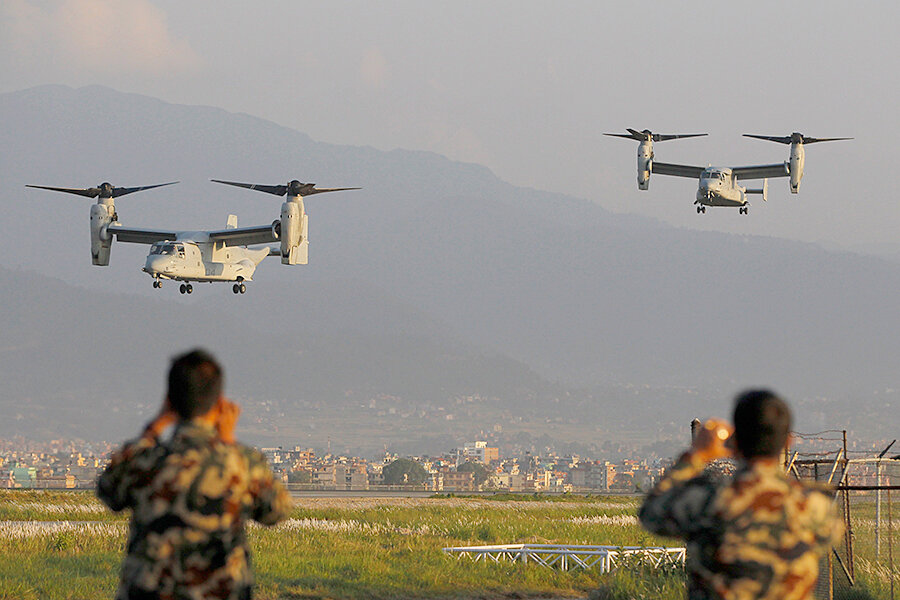Nepal earthquake: how one US aircraft could make a big difference
Loading...
| Washington
With the response to the earthquake in Nepal shifting from search and rescue to relief and reconstruction, a new clock is now ticking for the devastated Himalayan nation.
The race to rescue buried survivors of the April 25 temblor that left more than 7,000 dead and many more thousands injured has largely concluded – although “miracle” recoveries of survivors are still occurring, including that of a centenarian on Saturday.
The new clock focusing the attention of officials and international relief agencies is the one counting down the days until monsoon rains arrive, toward the end of next month. By that time, it will have been critical to deliver hundreds of thousands of tents and tarps to shelter the millions of Nepalese left either homeless or in precarious housing by the country’s worst quake in some 80 years.
More than a quarter of the population, or about 8 million Nepalese, have been left either homeless or with severely damaged shelter, according to the United Nations.
On Sunday, the United States upped its participation in the daunting effort to provide enough housing by sending five helicopters – including four coveted Ospreys – to assist in the delivery of shelter and basic house reconstruction materials.
The Ospreys, which have tilting rotors to allow the high-capacity transport aircraft to complete vertical landings and takeoffs, will be crucial to the effort to deliver materials to Nepal’s remote villages, many of which have been cut off from the rest of the world by massive landslides.
“The ability to fly in as a high lift-capacity airplane but then to land on a short strip – or simply to hover over a delivery site – is what makes the Osprey of particular value,” says David Michel, director of the environmental security program at the Stimson Center in Washington.
“[The Ospreys] are especially useful in Nepal which is so mountainous,” he adds. “Even when there is an airstrip, it’s notoriously short.”
Given that Nepal has just one airport capable of handling large fixed-wing aircraft, helicopters are playing a crucial role in the disaster response.
“We’re already hearing reports of damage to the one [runway] at the Kathmandu airport from all the aid flights coming in,” Mr. Michel says. “So these Ospreys are going to be really critical to getting aid out to the areas that are the hardest to reach.”
The US sent a disaster assistance response team, or DART, to the Nepalese capital of Kathmandu within hours of the magnitude-7.8 earthquake last month to help with search-and-rescue efforts. So far Nepal’s big neighbors, India and China, have played the lead roles in the international response.
But with the shift in emphasis from rescue to relief work, the US is expanding its participation with the dispatching of the Ospreys from their base in Okinawa, Japan.
The Nepalese government has made an initial request to international donors for 400,000 tents and tarpaulins, but many aid experts say the need across the poor country may very well end up outstripping that request.
The government has come under intense criticism both domestically and from international aid donors for a plodding and bureaucratic response to the earthquake and ensuing assistance offers. Locals say little if any aid is getting outside the capital, while Indian officials and other foreign donors complain that for days, Nepalese border agents held up truckloads of aid and demanded that normal customs duties be paid.
Even US military officials delivering the helicopters and other aid on Sunday said they were ready to bring in the assistance much earlier but had been held up in Okinawa for three days awaiting Nepalese government approval.
The US helicopters are not the first to be deployed in the earthquake response. The Nepalese military has a few helicopters, and India has dispatched more than a dozen to help out.
But the Ospreys will be especially useful in delivering heavy shelter materials in the coming crucial weeks, says Michel of Stimson.
“Just the additional lift capacity should be a big help,” he says. “But it’s the Osprey’s ability to fly into Nepal’s tightest valleys and then to hover over a devastated area to drop the supplies that really makes it a valuable addition to the relief effort.”








